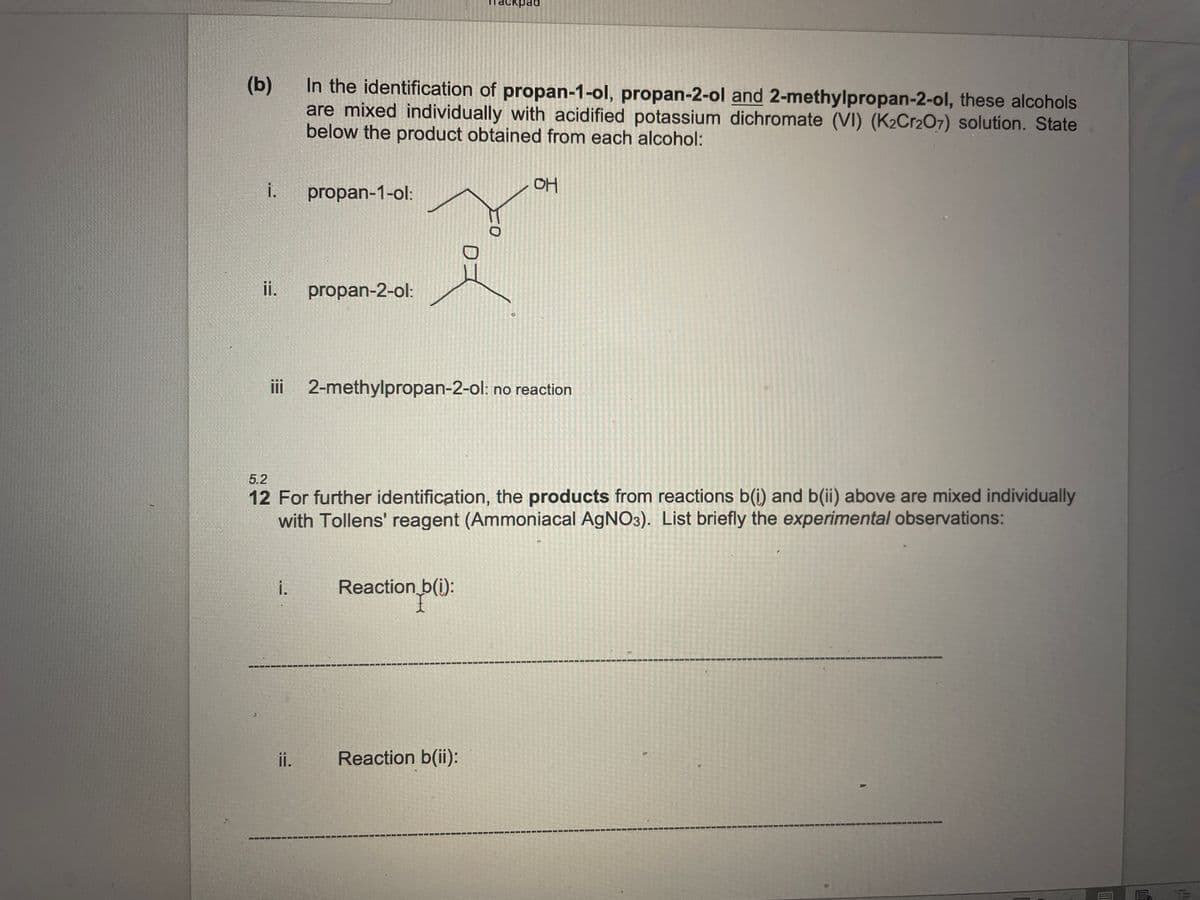(b) In the identification of propan-1-ol, propan-2-ol and 2-methylpropan-2-ol, these alcohols are mixed individually with acidified potassium dichromate (VI) (K2Cr207) solution. State below the product obtained from each alcohol: i. propan-1-ol: OH ii. propan-2-ol: iii 2-methylpropan-2-ol: no reaction 5.2 12 For further identification, the products from reactions b(i) and b(ii) above are mixed individually with Tollens' reagent (Ammoniacal AgNO3). List briefly the experimental observations: i. Reaction b(i): ii. Reaction b(ii):
(b) In the identification of propan-1-ol, propan-2-ol and 2-methylpropan-2-ol, these alcohols are mixed individually with acidified potassium dichromate (VI) (K2Cr207) solution. State below the product obtained from each alcohol: i. propan-1-ol: OH ii. propan-2-ol: iii 2-methylpropan-2-ol: no reaction 5.2 12 For further identification, the products from reactions b(i) and b(ii) above are mixed individually with Tollens' reagent (Ammoniacal AgNO3). List briefly the experimental observations: i. Reaction b(i): ii. Reaction b(ii):
Organic Chemistry
8th Edition
ISBN:9781305580350
Author:William H. Brown, Brent L. Iverson, Eric Anslyn, Christopher S. Foote
Publisher:William H. Brown, Brent L. Iverson, Eric Anslyn, Christopher S. Foote
Chapter6: Reactions Of Alkenes
Section: Chapter Questions
Problem 6.38P: Reaction of -pinene with borane followed by treatment of the resulting trialkylborane with alkaline...
Related questions
Question
Question 12 is needed help with

Transcribed Image Text:аскраd
(b)
In the identification of propan-1-ol, propan-2-ol and 2-methylpropan-2-ol, these alcohols
are mixed individually with acidified potassium dichromate (VI) (K2Cr2O7) solution. State
below the product obtained from each alcohol:
i.
propan-1-ol:
OH
ii.
propan-2-ol:
iii 2-methylpropan-2-ol: no reaction
5.2
12 For further identification, the products from reactions b(i) and b(ii) above are mixed individually
with Tollens' reagent (Ammoniacal AgNO3). List briefly the experimental observations:
i.
Reaction b(i):
ii.
Reaction b(ii):
Expert Solution
This question has been solved!
Explore an expertly crafted, step-by-step solution for a thorough understanding of key concepts.
Step by step
Solved in 2 steps

Knowledge Booster
Learn more about
Need a deep-dive on the concept behind this application? Look no further. Learn more about this topic, chemistry and related others by exploring similar questions and additional content below.Recommended textbooks for you

Organic Chemistry
Chemistry
ISBN:
9781305580350
Author:
William H. Brown, Brent L. Iverson, Eric Anslyn, Christopher S. Foote
Publisher:
Cengage Learning

Organic Chemistry
Chemistry
ISBN:
9781305580350
Author:
William H. Brown, Brent L. Iverson, Eric Anslyn, Christopher S. Foote
Publisher:
Cengage Learning